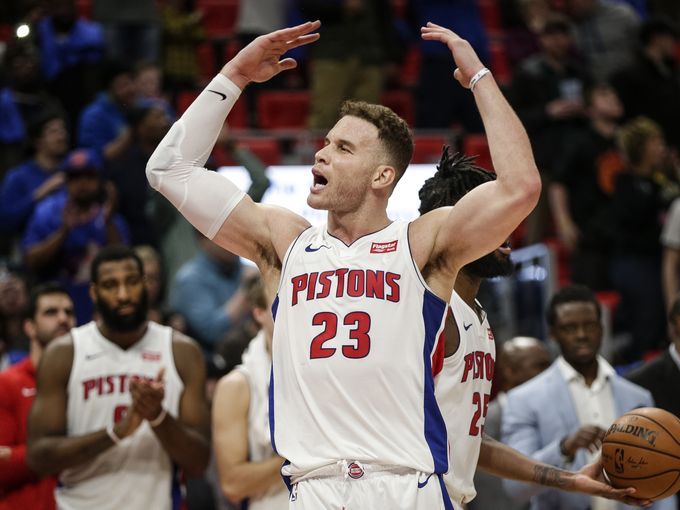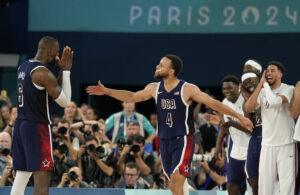- Attacking style not the only reason some Tottenham fans will back Ange Postecoglou until the bitter endPosted 5 months ago
- Paris Olympics takeaways: What did Team USA’s crunch-time lineup say about NBA’s hierarchy?Posted 10 months ago
- Zach Edey posted an easy double-double in Summer League debut. Here’s why he’ll succeed in NBAPosted 11 months ago
- What will we most remember these champion Boston Celtics for?Posted 12 months ago
- After long, seven-year road filled with excruciating losses, Celtics’ coast to NBA title felt ‘surreal’Posted 12 months ago
- South Florida men’s basketball is on an unbelievable heater– but also still on the bubblePosted 1 year ago
- Kobe Bufkin is balling out for Atlanta Hawks’ G League team. When will he be called up to NBA?Posted 1 year ago
- Former Knicks guards Immanuel Quickley, RJ Barrett may yet prove Raptors won the OG Anunoby tradePosted 1 year ago
- Rebounding savant Oscar Tshiebwe finally gets NBA chance he’s deserved for yearsPosted 2 years ago
- Is Tyrese Maxey vs. Tyrese Haliburton the next great NBA guard rivalry?Posted 2 years ago
Trading Blake Griffin was the wrong move–at the wrong time–for the Clippers
- Updated: February 8, 2018
The Microsoft magnate sat there in the front row, his bald head shining atop a furrowed brow, eyes staring out at the unfamiliar band of misfits he’s now employed to take the court at the Staples Center.
His Clippers had just played like, well the Clippers–pre-2000’s version, in a blowout loss to the Blazers, hours after his front office convinced him to trade his team’s biggest star.
For the first time in years, the Clippers had returned to the beta version of themselves, a basketball brand name synonymous with abject futility.
This wasn’t what Steve Ballmer envisioned when he bought the team a few years ago.
It takes a special kind of apathy to cause professional athletes in their 20’s to yearn to leave L.A., but that’s what Donald Sterling’s Clippers were—anemic, moribund, unimaginative, cheap, second or third-rate in every possible way.
The team shares a building with one of the greatest franchises in sports history, but seemed not only incapable of escaping the Lakers’ shadow but unwilling–almost as if they were basking in the shade.
Those Clippers, the Clippers most of us remember, were so bad that their 1997 squad, which finished 36-46 but stunningly, made the playoffs (!), can be counted as one of the finest in their history.
(Shout-out to Darrick Martin).
Things only started to turn around when Sterling got too old to care about running the team into the ground, and assets finally started emerging from the dumpster pile his negligence had created.
The Clippers went 47-35 in 2005-06, their first winning record in 14 years, and first playoff appearance since ’97. That group was led by solid players like Elton Brand, Sam Cassell and Cuttino Mobley, and had promising young guys like Chris Kaman and Corey Maggette. They looked like they were building something, even winning a playoff series before bowing out to the second-seeded Suns in the second round.
But then, the Clippers started ‘Clippering’ again. They bottomed out in ’08-09, like that car that you knew was going to break down yet again, despite the mechanic giving it a clean bill of health.
They went 19-63. That spring, they took Blake Griffin with the first pick in the NBA Draft.

The franchise has never been the same since Griffin got (and stayed) on the court in L.A., (AP Photo/Duane Burleson)
At the time, you wondered whether Griffin was going to fall victim to the Clips’ curse, like pretty much every other top pick they’d had. (Michael Olowokandi, Shaun Livingston, Danny Ferry, Loy Vaught, we could go on…)
This kid who looked like a sure thing was suddenly not-so-sure, just because of where he was about to be playing.
And then he did–at least in his rookie season, which he missed entirely after breaking his left kneecap in the team’s final preseason game.
It was the last, awful break for those Clippers. And then, everything changed.
It started when the team acquired Chris Paul, undoubtedly the greatest player ever to don a Clippers jersey, and he, Griffin, and to a much lesser extent, DeAndre Jordan, ushered in the greatest era in team history.
The Clips gave up on that core in the offseason, when they shipped the diva-like Paul to Houston, scarred by years of horrendously-timed injuries and one epic collapse.
Like most teams in the NBA, the Clippers’ plans have been altered by the dynastic Warriors. Golden State has taken special satisfaction in absolutely humiliating the Clips, dominating them at their own tempo-conscious game, and beating them by a larger margin than any other team in the league over the past few seasons.
With the W’s at the peak of their powers, there’s no doubt–the Clips weren’t winning an NBA championship any time soon.
But for a franchise as irrelevant as the Clippers have been since they ran aground in L.A. from San Diego, is that really the only goal?
Most people around the league praised Jerry West and Lawrence Frank for trading Griffin on that Monday in February, celebrating the return of Avery Bradley, Tobias Harris, Boban Marjanovic, and a couple of draft picks, as if it were worth dealing the only future Hall of Famer the franchise could really call its own.
If Chris Paul put the franchise on the map, Griffin was going to keep them there–and that was the thinking behind the five-year, $173 million contract extension the two sides agreed to in June.
Griffin was going to have his jersey retired, the only Clippers number hanging in the rafters alongside all of those Lakers greats. So much for that.
Yes, Griffin was mercurial, and perhaps a little bit overrated (he can’t create his own offense like a true No. 1 option should). But he was the biggest basketball star in L.A., and the main thing separating the Clippers from the suddenly less-successful and less-entertaining Lakers.
Unless you think LeBron is walking through that Staples Center door (and not on the other side)…what was the point of this again?
If I were Steve Ballmer, I’d probably be staring blankly out at this squad of second-stringers, too. His face said it all:
I can’t believe I let those guys talk me into this.

Lou Williams has been outstanding this year, but can the Clips really expect this going forward? (Photo by Andrew D. Bernstein/NBAE via Getty Images.)
After re-signing the suddenly emergent Lou Williams, and with a nucleus of DeAndre Jordan, Danilo Gallinari and Milos Teodosic, among others, this was a playoff team for a few years to come.
Now, who knows?
Avery Bradley is a free agent next year. Tobias Harris, who was having a career year in Detroit (18.1 ppg, 5.1 rpg), has one more year before free agency. It’s doubtful both (or either) will sign a long-term deal with L.A.
That 2018 first-round pick the Clips got in return will be in the middle of the first round, at best, and most likely lower, the way Griffin and his new Lob/Motor City teammate Andre Drummond are playing (they haven’t lost since the trade).
Analytics might tell you that the worst thing you can be in the NBA is mediocre. Not good enough to compete for a title, not bad enough to secure a top draft pick.
But Clippers fans know there’s something much worse than that.
They’ve been through it, for decades. Until recently, when for a glimmering moment in time, they mattered.
After trading Griffin, you can’t say that anymore.
After years as a leading sixth man, Lou Williams is now the lead dog for the contending Clippers





